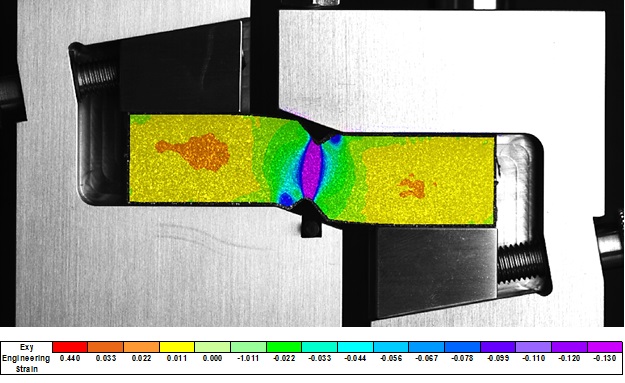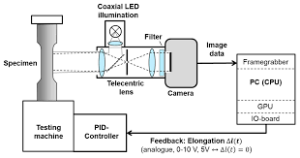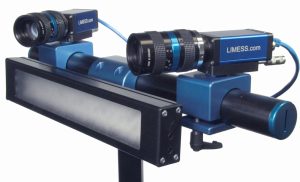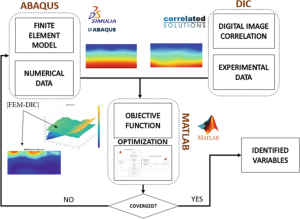
Digital image correlation (DIC) is a non-contact optical method used to measure surface deformation on objects. It tracks displacements in subsets (highlighted in red) of the speckle pattern during deformation. DIC has demonstrated accuracy compared to LVDTs, strain gauges, and FEA models. It is widely recognized as the industry-leading optical measurement method worldwide. DIC systems from Correlated Solutions employ advanced hardware for speed, robustness, and accurate data generation.
What is digital image correlation?
Digital image correlation (DIC) is a non-contact optical method used to measure full-field displacements and strains in materials and structures. It is commonly employed in experimental mechanics and materials science to analyze the deformation and motion of objects under various loading conditions.
- The Digital Image Correlation (DIC) technique is a non-contact, full-field measurement approach.
- DIC enables the assessment of the deformation and motion of objects.
- DIC involves comparing digital images of the object before and after deformation.
- DIC is used to track surface patterns on an object.
- DIC captures images before and after deformation to gather data on displacement and strain.

The Basic
Displacement in image correlation
- Displacement is the movement of a point or area on an object’s surface before and after deformation.
- In DIC, displacement is measured by tracking markers or patterns on the object’s surface.
- The software calculates displacements by comparing marker positions in images before and after deformation.
- Displacement is represented as a vector quantity, conveying magnitude and direction.
Deformation in image correlation
- Deformation is the change in size or shape of an object caused by external forces or loads.
- DIC characterizes the change in geometry during deformation.
- DIC enables the measurement and analysis of deformation by quantifying strain fields.
- Strain is derived from displacement data and measures the object’s change in shape or size.
Digital image correlation process and output data
- The process includes image acquisition, preprocessing, pattern or marker identification, deformation analysis, and post-processing/visualization.
- High-quality images are captured by a camera or group of cameras before and after the change.
- The images are used to measure how the object changes shape and moves.
- The acquired images undergo processing techniques to enhance quality and minimize unwanted effects that may affect tracking.
- Digital image correlation software identifies and tracks markers on the object’s surface using correlation-based methods or feature detection algorithms.
- Marker positions are compared to calculate displacement and strain fields, providing insights into localized strain distributions.
- The software extracts relevant data and presents it visually through techniques like contour plots or animations.
DIC system and software applications
- DIC software finds applications in areas like material testing, structural engineering, biomechanics, and geotechnical engineering.
- DIC is particularly useful for studying mechanical properties, complex deformations, and obtaining detailed strain information.
- DIC is a non-invasive and non-contact optical technique that can measure an entire field, providing insights into how objects respond to various loads.
Digital image correlation in engineering
- DIC is commonly used in experimental mechanics and materials science to obtain accurate measurement data.
- In mechanical engineering, digital image correlation is extensively used to monitor and process test data in both research and industrial settings.
- It finds applications in various areas, from common material testing to the characterization of large and intricate components such as airplane parts, roadway bridges, and nuclear power plant structures.
- Digital image correlation is a versatile method that can be applied to structures of any shape, size, or material, as long as they are visible to cameras.
- It is a contactless and non-destructive technique.
Digital image correlation algorithms
Digital image correlation algorithms rely on tracking information across a series of images, starting from a “reference image” and progressing to subsequent “deformed images” captured during the test. These images form a sequence or “movie” from which displacement measurements are derived.
Key Advantages of Digital Image Correlation (DIC)
DIC is a non-contact method, eliminating the need for mechanical connections to the test object surface. This removes mechanical limitations and constraints. It provides full-field results by measuring shape, displacement, and various forms of strain over the entire optically visible image. DIC is versatile, with no speed limitations or optical constraints, and can measure objects of different shapes, sizes, and motion frequencies. It achieves sub-pixel accuracy, resolving both in-plane and out-of-plane microstrains.
- Full-field Measurements: DIC provides full-field measurements of displacement and strain across the entire surface of an object. This allows for a comprehensive understanding of the deformation behavior, capturing localized effects and identifying areas of interest that may be missed by point-based measurements.
- Non-Contact Method: This means it doesn’t require physical contact with the object being measured. This is particularly advantageous when dealing with delicate or sensitive materials where direct contact could alter the behavior or introduce errors in the measurements.
- High Spatial Resolution: DIC can achieve high spatial resolution by using high-resolution cameras and advanced image processing algorithms. This enables the detection and measurement of small displacements and strains, providing detailed information about the material’s response.
- Flexible and Versatile: DIC is a versatile technique that can be applied to various materials and structures, regardless of their size, shape, or complexity. It can be used for both static and dynamic measurements, making it suitable for a wide range of applications.
- Real-Time Monitoring: DIC can provide real-time measurements, allowing for the monitoring of deformation and motion during experiments or tests. This real-time feedback can be valuable for controlling and adjusting loading conditions or experimental parameters.
- Post-Processing Capabilities: DIC generates a large amount of data, which can be further analyzed and processed to extract additional information beyond displacement and strain. For example, it can be used to visualize deformation modes, identify stress concentrations, or validate numerical models through comparison with simulation results.
How does Digital Image Correlation work?
DIC works by tracking the movement of patterns or features on the surface of an object captured by a pair of digital images. The process involves the following steps:
- Image Acquisition:
Two images of the object are captured using a digital camera. These images were taken before and after deformation or motion occurred.
- Image Preprocessing:
The acquired images are typically preprocessed to enhance contrast, remove noise, and improve the visibility of the patterns or features on the surface.
- Image Correlation:
The preprocessed images are divided into small regions or subsets, typically square or rectangular. The subsets in the reference image are then compared to the corresponding subsets in the deformed or subsequent image.
- Pattern Matching:
The subsets in the reference image are compared to the subsets in the deformed image using various correlation algorithms to determine the displacement or strain between the two images. The correlation algorithms estimate the best match between subsets by calculating the similarity, or correlation coefficient.
- Displacement Calculation:
The displacement field is obtained by correlating all subsets in the reference and deformed images. The correlation results provide information about the full-field displacement of the object’s surface.
- Strain Calculation:
From the displacement data, strain fields can be calculated by differentiating the displacement field. Strain represents the deformation of the material and can provide insights into the mechanical behavior of the object.
DIC finds applications in various fields, including materials testing, structural analysis, biomechanics, geomechanics, and manufacturing quality control. It enables researchers and engineers to study the mechanical behavior of materials, validate numerical simulations, and assess the performance of structures under different loading conditions.
Measurement Principle
DIC is an image analysis technique that utilizes grayscale digital images to analyze the entire surface of an object under load. It can accurately determine the object’s contour and measure its displacements in three dimensions.
The EduDIC is a cost-effective and user-friendly Digital Image Correlation (DIC) measurement system specifically designed for academic training in experimental solid mechanics and materials testing. It serves as an entry-level tool that allows instructors and students to perform optical DIC measurements for various research, workshops, and laboratory exercises.
The system offers flexibility and adjustability, allowing users to freely align and move the cameras on the mounting bar. This feature enables the utilization of different stereo-angles and baseline distances, thereby enhancing the accuracy of in-plane or out-of-plane measurements.
The FlexDIC system
The FlexDIC system is an optical measurement device that offers complete non-contact, three-dimensional measurement capabilities for analyzing the shape, displacements, and strains of components and structures made from a wide range of materials.
This system is utilized to determine the three-dimensional material properties during various types of tests, such as tensile, torsion, bending, or combined tests. Additionally, it enables deformation and strain analysis in applications including fatigue tests, fracture mechanics, validation of finite element analysis (FEA), and many other areas of study.
The flexible design of the FlexDIC system allows for a broad spectrum of applications, ranging from microscopic examinations of microelectronic or biomedical materials to large-scale measurements of aerospace, automotive, marine, and railway components.
The MulticamDIC system
The MulticamDIC is an advanced, application-specific Digital Image Correlation (DIC) measurement system that utilizes a combined stereo-rig array of 4 or more (up to 16) USB3 or GigE cameras. This system is designed to enable testing engineers to conduct large-scale and complex surface testing of both sub-components and structures.
One of the key advantages of the MulticamDIC system is its ability to expand the field-of-view (FoV) to cover multiple square meters (up to approximately 25–30 m2) by leveraging the additional views provided by multiple cameras, all while maintaining spatial accuracy. This allows for comprehensive visualization and measurement of complete components, objects, and structures.
The MulticamDIC system allows for the arrangement, configuration, and setup of multiple cameras in a clustered array tailored to specific material testing applications. The advantage of this system lies in its capability to perform DIC measurements on large, complex surfaces with contoured geometries and double-sided features that would not be feasible to measure using a single stereo-rig DIC system.
The HSpeedDIC system enables full-field, non-contact, and three-dimensional dynamic measurement of shape, displacements, and strains on components and structures made from nearly any material. It is specifically designed for conducting full-field vibration analysis and capturing high-speed transient events using the digital image correlation technique.
The HSpeedDIC system:
This system is particularly well-suited for applications such as ballistics testing, fracture mechanics, shock excitations, the Hopkinson Bar test, and impact testing. It offers a dynamic range that spans from static measurements to frequencies exceeding 100,000 Hz. The HSpeedDIC system can measure displacements ranging from microns to meters, with a typical resolution of around 1 micron and 0.01% strain.
The system’s versatility allows it to be used for objects of varying sizes by simply adjusting the optical lenses. Additionally, the availability of various extensions and application accessories facilitates easy integration of the HSpeedDIC system into different experimental setups.
The ThermechDIC system
The measurement results obtained through DIC are utilized for evaluating the thermal mismatch (coefficient of thermal expansion, CTE) within components. Furthermore, DIC enables warpage analysis, which can be employed for validating finite element analysis (FEA) models. One of the advantages of DIC is its ability to process information in real-time, allowing for quick data acquisition, evaluation, and visualization during the measurement process.
The ThermechDIC system consists of the following:.
- Stereo-rig DIC system with a hot/cold stage
- Temperature controller
- Liquid N2 pump & controller
- Dewar/tank
To facilitate measurements, the DIC stereo-rig can be mounted on a motorized mounting frame or utilized alongside a stereoscopic microscope (µDIC).
The videoextensometer RTSS system:

The system offers accurate and full-field measurements, with sub-micron resolution, for determining the Coefficient of Thermal Expansion (CTE), warpage, and strain under thermal loads. It utilizes the Videoextensometer, which enables the measurement of longitudinal and transversal strain during material tests such as tension and compression tests. Additional analysis modules are available for determining crack length and crack areas in long-term tests and bondings.
The videoextensometer RTSS is specifically designed for determining material properties in tension tests, providing contactless deformation measurement. It enables the determination of stress-strain curves, E-modulus, and Poisson’s ratio.
Key features of the system include contactless and camera-based strain measurement ranging from 20µm/m to over 1000%, flexibility in specimen size from a few millimeters to several meters, easy setup and specimen marking, compatibility with all testing machines, and applicability to all materials.
- digital image correlation python
- digital image correlation software
- Digital image correlation formula
- digital image correlation Matlab
- Digital image correlation example
- digital image correlation principle
- digital image correlation camera
- digital image correlation strain measurement
Read More:





